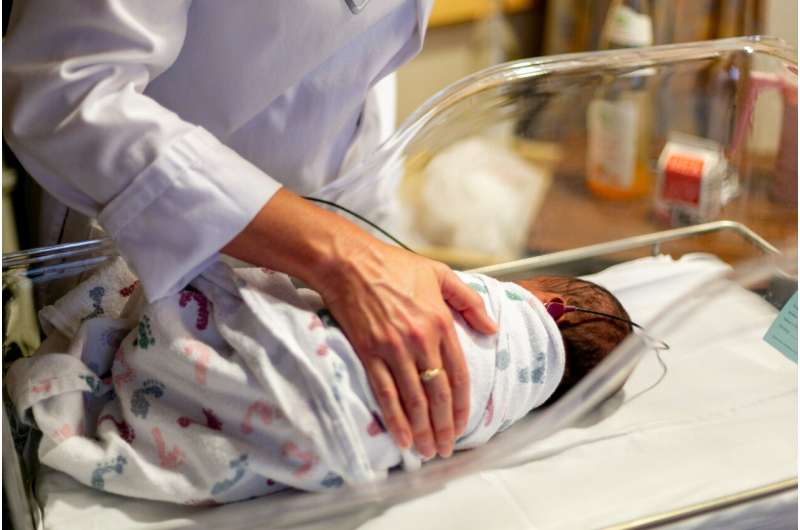This article has been reviewed according to Science X's editorial process and policies. Editors have highlighted the following attributes while ensuring the content's credibility:
fact-checked
trusted source
proofread
Women with adenomyosis may face increased risk of pregnancy and childbirth complications

Women with adenomyosis—a chronic condition that can cause pelvic pain and heavy menstrual bleeding—are at increased risk of infertility as well as problems in pregnancy and during birth, according to research presented at the 39th annual meeting of the European Society of Human Reproduction and Embryology (ESHRE).
Data from the first study of its kind, based on more than nine million women, show that mothers-to-be with adenomyosis experienced higher rates of complications.
The greatest risk was for cesarean section delivery—this was 20 times higher for women with adenomyosis than for those without the condition. The likelihood of surgical removal of the uterus and wound complications was also much increased, according to the findings.
In their conference presentation, the authors suggest more monitoring is needed of the millions of women worldwide with adenomyosis. This may help prevent or reduce the risk of serious complications for women, or even death for them and their babies, they say.
Lead author Dr. Mohammed Bazarah, from the University of Western Ontario, London (Canada), said, "Women with adenomyosis are more likely to experience infertility, preterm delivery and other gynecological conditions such as endometriosis.
"This study provides in-depth analysis of its effects on pregnancy which are potentially due to many factors such as chronic inflammation. The findings will help guide how doctors monitor and care for patients."
Adenomyosis affects an estimated one in ten women of reproductive age. It occurs when endometrial tissue and glands that normally line the womb are found in or grow into the muscle wall of the uterus.
During menstruation, this tissue thickens and bleeds as it normally would in the uterus. Symptoms can include severe cramps, heavy bleeding and pain during sex. However, some women experience no physical signs which makes the condition hard to diagnose.
Adenomyosis can occur with endometriosis which is a similar but separate condition.
Studies have already shown that patients with adenomyosis are more likely to experience obstetric and gynecological problems, but guidance on how to deal with these issues is limited.
The authors of this new study, who also included those from McGill University, in Montreal (Canada), set out to provide in-depth insights into maternal, pregnancy and neonatal outcomes in women with adenomyosis.
They used records from 2004 to 2014 from the Nationwide Inpatient Sample (NIS) database. The NIS is part of the Health Care Cost and Utilization Project, the largest collection of inpatient hospital care data in the US.
The study group was based on 9,094,321 women without adenomyosis who were pregnant and 2,467 mothers-to-be with adenomyosis. The reproductive outcomes for women with adenomyosis and those without the condition were compared.
Results showed patients with adenomyosis were more likely to be older, obese, have chronic hypertension, thyroid disease, pre-gestational diabetes, and to have had a previous C-section and IVF.
Compared with women without adenomyosis, these patients had a 5.86 times higher risk of the baby's exit via the vagina being blocked by the placenta covering the opening to the cervix. This condition is known as placenta previa.
They were also 1.69 times more likely to develop pre-eclampsia, a condition unique to pregnancy associated with high blood pressure and a high level of protein in urine, and 1.5 times more likely to develop hypertension.
Their relative risk of obstetric complications was 21.63 times higher for C-section, 6.39 for hysterectomy, 2.37 for wound complications, 2.25 for blood transfusions, 2.17 for the placenta detaching from the uterus wall, 1.97 for suffering excessive bleeding after the baby's birth, and 1.82 for maternal infection.
The study did not investigate why these risks in pregnancy were increased. However, Dr. Bazarah said there could potentially be multiple causes such as inflammatory changes, alteration of placental blood flow, older age, increased rates of using assisted reproductive technology, and benign tumors caused by adenomyosis.
"The higher C-section rate may be due to the increased risk of pregnancy complications such as pre-eclampsia and placenta previa," he added.
A limitation of the study was that the databases used by the authors did not specify how each woman's adenomyosis was diagnosed or how severe the disease was.
The chair of ESHRE, Professor Carlos Calhaz-Jorge from the Northern Lisbon Hospital Center and the Hospital de Santa Maria in Lisbon (Portugal), was not involved in this research. He said, "Adenomyosis can disturb the function of the uterus, and this may affect how pregnancy evolves and how many children a woman has. The condition frequently occurs together with endometriosis, another poorly-understood disorder.
"These comprehensive research findings should help to ensure pregnant women with adenomyosis get the extra monitoring and care they may need. More research is urgently needed into this very common but often debilitating condition."
More information: Presentation no: O-269, "Reproductive and Neonatal Outcomes in Women with Adenomyosis: A Population-based Study", presented by Mohammad Bazarah, session 81: Management of adenomyosis: current strategies and future perspectives, Auditorium 10-12, 11.00 hrs CEST, Wednesday 28 June 2023.




















